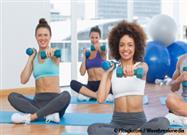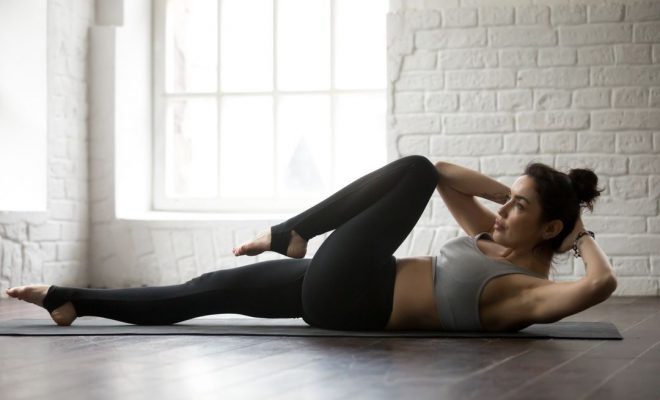5 Movements That Reveal Your Fitness Weaknesses

Poor balance andcoordination, weakness or inflexibility in your arms, hips and legs, poorposture, and lack of core strength — these are all factors resulting frominactivity that can lead to stumbling, falls, disability, declining health, andpremature death.
Most people don’trealize that their physical fitness is on a downward slope until they have anaccident, or find themselves unable to move around as they once did. At thatpoint, while not impossible, it can certainly be far more difficult to make theproverbial U-turn.
Fortunately, there aresome very simple tests that can give you an indication of where you currently stand.
As described in anearlier article, a simple sitting test may even predict your longevity. How well youcan sit and rise from the floor is thought to indicate your risk of dying overthe next six years or so.
Mobility and Health Are Linked
Simple movement testslike these are based on the idea that there’s a connectionbetween mobility and health, and if you find yourself struggling to performthem, they may provide the incentive you need to get back in shape.
As noted in a recentGreatist article:1
“No matter if you’re an occasional gym-goer or a committedCrossfitter, there are a few moves everyone should be able to do with ease.They serve as a foundation, and chances are, you’re already doing a version ofthem every day without even knowing.
For example, tons of everyday movements are essentially a squat …Picking up something you dropped or lifting your pet off the ground are bothgood examples …”
Once movements such assquatting to pick something off the floor or walking up a flight of stairsbecome a challenge, your overall quality of life tends to dwindle, as lack ofmobility begets more inactivity.
And, as noted in many previous articles, sitting is an independent risk factor for chronic disease and early death.
Assess Your Upper Body and Core Strength With a Push-Up
Having a strong core andupper body will allow you to maintain goodposture, balance, and stability, and conduct everyday movements like reachingand bending more easily and safely.
Two exercises that can help you assess your core strength are the classic push-up and the plank. In the video below, fitness trainer Darin Steen demonstrates theproper form for a push-up, as well as more advanced techniques to targetdifferent muscle groups.
The featured Greatist article2 also provides quick demos of each of the movements included in this article, aswell as the most common mistakes made.
How to Perform a Push-Up, and What It Means If You Can’t
Here’s a summary of thebasics of proper form:
1. Start in high plank position. Your back and legs should be flatand straight, resting on your toes; your core engaged; your hands level withyour chest, and arms fully extended. Pay careful attention and make sure youdon’t drop your head forward; it needs to be in line with your back.
2. Slowly and deliberately bend your arms at 90 degrees to drop yourchest toward the floor, allowing your sternum to gently touch the ground.
Pause there, contracting your core for about 3 seconds, then push yourself backup. Your arms should be straight, without locking your elbows.
3. Pay attention to the alignment of your elbows. The ideal anglefrom your sides is about 45 degrees. This allows you to effectively work yourchest muscles and prevent injuries from overextension.
4. Breathe in on the way down; breathe out on the way up, throughyour nose, not your mouth.
The inability to perform a properpush-up can indicate a couple of problem areas, depending on your weakness:
- Inability to bend your elbows and lower your chestall the way down suggests you lack strength in your arms, shoulders, and chest.
- Inability to maintain your back and legs in a rigid,flat position, thereby allowing either your hips or lower back to sag, suggestsa weakness in your core and/or glutes.
Assess Your Core Strength With a Forearm Plank
Total video length: 8:11
To do a forearm plank,you hold your body (the trunk portion) off the ground, making sure to hold itin a straight line, balancing on your toes and elbows. While getting into theproper position is straightforward, holdingit takes strength and endurance in your abs, back, and core.
A strong core will also help prevent back pains, and help youmaintain strong continence.
In the video above, Jill Rodriguez demonstrates a number of plankvariations. The one you’re going to focus on for this general core strengthtest is the basic intermediate forearm plank, demonstrated at 1:20.To engage your core, be sure to pull in your belly button. Yourbelly button is attached to your transverse abdominis, that inner sheath thatholds your gut inside and gives your spine and vertebrae a nice, weightbelt-tightening type of support.
So by pulling it in, you begin to contract that deep innertransverse abdominis muscle. You’ll want to maintain this position, keepingyour back flat and in line with your neck, for anywhere from 30 to 60 seconds.If you can hold it for at least two minutes, you’re off to a good start.
Lack of core strength is demonstrated by your hips coming out ofalignment, either sagging downward or hiking upward in the form of anupside-down “V.” Being unable to hold a plank for about two minutes may alsoindicate that you’re carrying too much weight, and would benefit from sheddinga few pounds.
Assess Your Hip Flexibility, Balance, and Leg Strength With a Squat
In the video above, Darindemonstrates safe squattechniques for beginner, intermediate andadvanced. Here’s a summary of the basics:
- Stand with your feet just over shoulder width apart. Keep yourback in a neutral position, and keep your knees centered over your feet.
- Slowly bend your knees, hips and ankles, lowering until you reacha 90-degree angle. Make sure your hips are kept in line over yourknees, and your knees over your ankles.
- Return to starting position.
- Breathe in as you lower, breathe out as you return to startingposition.
What does it mean if youcannot perform a proper squat?
- The inability to bend your knees and ankles, thereby disallowingyour hips to hinge all the way back, will result in a movement in which you endup raising up on your toes. This suggests tightness in your hip extensorsand/or hamstrings, and you’d be wise to start working on improving your hipflexibility.
- If your knees buckle inward upon lowering or raising yourself up,your hamstrings and glutes are the areas of weakness.
Assess Your Shoulder Strength and Range of Motion With a Dumbell Overhead Press
The standing dumbbell overheadpress will assess your shoulder strength and range of motion. Research3 has found that standing during this exercise produces far greater muscleactivation across the various muscles, compared to seated overhead presses. Forexample, compared to the seated dumbbell overhead press, the standing overheadpress resulted in an:
- 8 percent greater muscleactivation of the front shoulder (anterior deltoid)
- 24 percent greater muscleactivation of the back shoulder (posterior deltoid)
- 23 percent greater muscleactivation of the biceps
To perform a proper dumbbelloverhead press, stand with feet shoulder width apart, holding one dumbbell ineach hand of a suitable weight. Avoid using weights that are excessively heavy,as this will simply degrade your form. You want to be able to do at least 8 to12 repetitions for this exercise. Keeping your wrists turned inward, lift theweights to starting position, level with your shoulders.
Proper form duringthe beginning and end of this exercise is important, to take a look at theshort video above for a demonstration. Press the weights up overhead, fullyextending your arms before lowering the weights back down to your shoulders. Avoidjerking; the motion should be controlled and fluid.
- The inability to extend your arms straight up overhead suggests a lack of range of motion in your shoulder girdle and weakness in yourback muscles.
- If you find you have to arch your back to raise the weights, youprobably have weak core muscles, resulting in a lack of stability, or that yourhip flexors are too tight, thereby preventing the proper alignment of your hipsand knees.
Assess Your Balance and Coordination With a Forward Lunge
Stationary and walking lunges helpbuild lower-body strength while improving balance, flexibility and stability inyour hips. This is important for everyday movements such as being able to climba flight of stairs. I like incorporating simple exercise movements into myeveryday routine, outside of my regular workout, and lunges are easy to do whenmoving about from room to room for example.
I suggest doing about 30 throughoutthe day, whenever you’re up and moving around anyway. I usually do them whenwalking from my office to the kitchen several times a day. The only requirementreally is to make sure your pants aren’t too tight.
The only difference between awalking lunge and a stationary forward lunge is that in the former, you’repropelling yourself forward, whereas in the latter you return to your startingposition. Either one will serve as far as this test goes. To perform a stationary lunge:
- Stand with your feetshoulder-width apart. Next, take a long step forward with your right foot. Yourfront heel should be flat on the floor.
- Keeping your upper body straight,descend into lunge position by bringing your back (left) knee towards thefloor. Stop just short of the knee touching the ground, with your front heelstill flat on the floor. Ideally, both legs should be bent to 90 degrees, withyour front knee positioned directly over your front foot.
- Pause for one second and thenpush off from your right foot to return to standing. Repeat on the other side.
Weaknesses arerevealed if you:
- Don’t step far enoughforward. This suggests a weakness in your glutes, and/or lack of flexibility inyour hip flexors or hamstrings. Strengthening and increasing flexibility inthese areas will allow you to step further forward and bend deeper.
- Lean your chest toofar forward. While a slight forward motion is natural, an excessive forwardlean suggests a weakness in your glutes and core muscles. Be sure to engageyour glutes and hamstrings when performing the movement, and avoid leaningforward.
In the video below, Darindemonstrates walking lunge with dumbbells, but you can certainly do them without thedumbbells when first starting out. Using weights will further build yourlower-body strength though.
Functional Movement Is Part and Parcel of Health and Longevity
If you maintain good functionalmovement, balance, flexibility and coordination, there’s nothing stopping youfrom leading an active life well into old age. Declining quality of life, alongwith declining health, is an outgrowth of restricted mobility and subsequentinactivity. Once you stop moving, your body inevitably starts degenerating. Thefive simple movement tests reviewed above provide easy measures of where yourweaknesses are, and what you need to work on.








